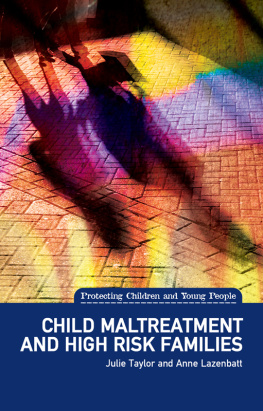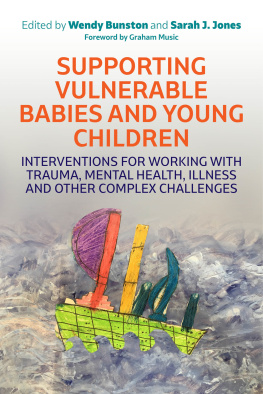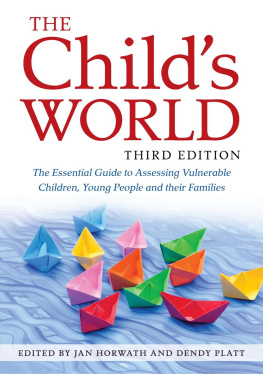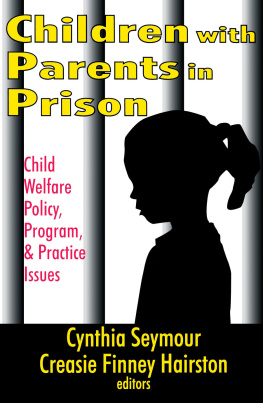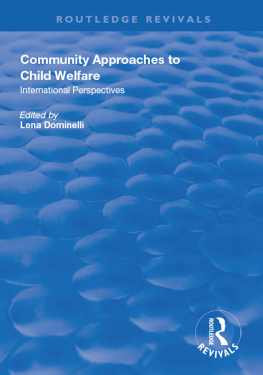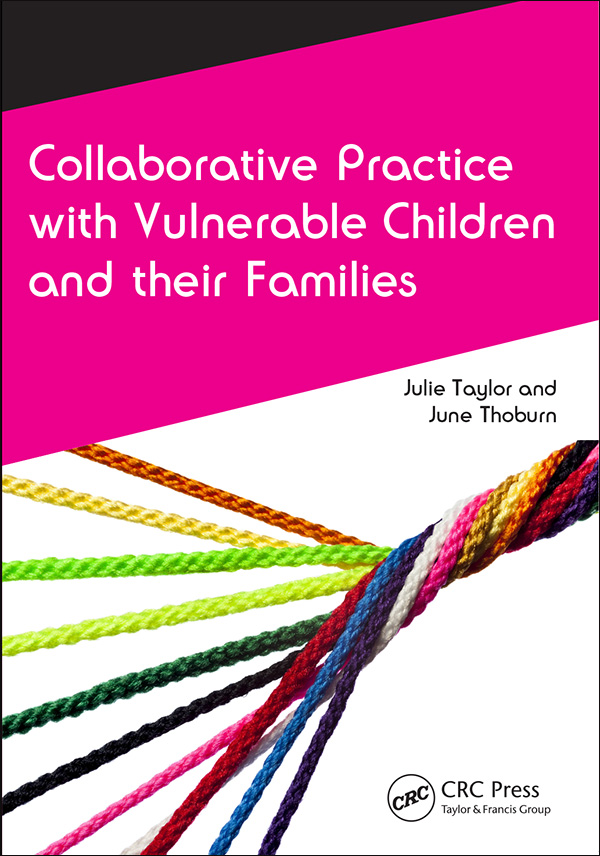Contents
Collaborative Practice with Vulnerable Children and their Families
Julie Taylor
Professor of Child Protection School of Health and Population Science University of Birmingham
June Thonurn
Emeritus Professor of Social Work University of East Anglia
Series Editors
H,ugh Barr and Marion Helme Centre for the Advancement of Interprofessional Education

CRC Press
Taylor & Francis Group
6000 Broken Sound Parkway NW, Suite 300
Boca Raton, FL 33487-2742
2016 by Taylor & Francis Group, LLC
CRC Press is an imprint of Taylor & Francis Group, an Informa business
No claim to original U.S. Government works
Printed on acid-free paper
Version Date: 20151120
International Standard Book Number-13: 978-1-84619-896-0 (Paperback)
This book contains information obtained from authentic and highly regarded sources. While all reasonable efforts have been made to publish reliable data and information, neither the author [s] nor the publisher can accept any legal responsibility or liability for any errors or omissions that may be made. The publishers wish to make clear that any views or opinions expressed in this book by individual editors, authors or contributors are personal to them and do not necessarily reflect the views/opinions of the publishers. The information or guidance contained in this book is intended for use by medical, scientific or health-care professionals and is provided strictly as a supplement to the medical or other professional's own judgement, their knowledge of the patient's medical history, relevant manu- facturer's instructions and the appropriate best practice guidelines. Because of the rapid advances in medical science, any information or advice on dosages, procedures or diagnoses should be independently verified. The reader is strongly urged to consult the relevant national drug formulary and the drug companies' and device or material manufacturers' printed instructions, and their websites, before administering or utilizing any of the drugs, devices or materials mentioned in this book. This book does not indicate whether a particular treatment is appropriate or suitable for a particular individual. Ultimately it is the sole responsibility of the medical professional to make his or her own professional judgements, so as to advise and treat patients appropriately. The authors and publishers have also attempted to trace the copyright holders of all material reproduced in this publication and apologize to copyright holders if permission to publish in this form has not been obtained. If any copyright material has not been acknowledged please write and let us know so we may rectify in any future reprint.
Except as permitted under U.S. Copyright Law, no part of this book may be reprinted, reproduced, transmitted, or utilized in any form by any electronic, mechanical, or other means, now known or hereafter invented, including photocopying, microfilming, and recording, or in any information storage or retrieval system, without written permission from the publishers.
For permission to photocopy or use material electronically from this work, please access www.copyright.com (http://www.copyright.com/) or contact the Copyright Clearance Center, Inc. (CCC), 222 Rosewood Drive, Danvers, MA 01923, 978-750-8400. CCC is a not-for-profit organization that provides licenses and registration for a variety of users. For organizations that have been granted a photocopy license by the CCC, a separate system of payment has been arranged.
Trademark Notice: Product or corporate names may be trademarks or registered trademarks, and are used only for identification and explanation without intent to infringe.
Visit the Taylor & Francis Web site at
http://www.taylorandfrancis.com
and the CRC Press Web site at
http://www.crcpress.com
Collaborative Practice with Vulnerable Children and Their Families is being published at a very opportune time. The issues it addresses are increasingly important for a growing number of agencies and professionals whose work brings them into contact with children, young people and their families. For some years it has been recognised that it is no longer appropriate for those working in the broad health, welfare and criminal justice fields to see and carry out their work in professional compartments and silos. Since the 1970s official reports and guidance has stressed the importance of professionals working together to identify and prevent cases of actual or potential child abuse, particularly in relation to the sharing of information and, increasingly, responsibility. However, no longer is this seen as an issue only where there are concerns about child abuse - the need for collaboration is seen as equally important if help and support is to be made available at a much earlier stage. Concerns about intervening with vulnerable children, young people and their families are now seen as of considerable political and policy significance. However, quite what this means and how it should be carried out in practice is a much greater challenge.
Julie Taylor and June Thoburn attempt to address this challenge - or rather challenges - head on. They choose their words carefully as they recognise the language used, as well as the practices and organisational arrangements the language is meant to represent, is very slippery and open to wide interpretation and misunderstanding. Collaboration helpfully provides something of an umbrella term to cover the many ways that professionals, agencies, volunteers and families can and do work together, while the term vulnerable is understood in terms of children and young people who are actually or potentially experiencing cumulative harm in terms of more than one adversity and hence would benefit from some additional, targeted services. In many respects for the latter to be successful requires the former, in a variety of forms, to be evident.
Throughout, the book is written in a very accessible style and will be of considerable interest and use to a diverse range of practitioners, managers and trainers working in a variety of settings. It discusses the relevant mandates, statutes, guidance and organisational contexts for such work together with the relevant research and knowledge base which informs it. The book stresses the importance of the value base for working collaboratively with vulnerable children and families, and throughout provides a series of quite different case vignettes and exercises which can be carried out either individually or in groups. These act to really bring the text to life and help the reader to make links with practice in such a way which does not underestimate the complexities and challenges with such work. Importantly, it clearly identifies the key features of what good collaborative working entails.
It is also clear that the policy environment is making the need for such work even more central. It isnt simply that there is an expectation that professionals should become involved earlier and hence prevent problems from getting worse but that the complexity of the work is itself growing. Not only are new types and dimensions of childrens vulnerability being discovered all the time but the range and types of agencies operating in the field are themselves becoming more diverse, fluid and, argu- ably, fragmented. The growth of the private sector, social enterprise agencies and the general move to a culture of service commissioning and specialisation, as well as the exponential growth in the use of various forms of information technology, means that the need for, and expectations regarding, collaboration have increased in recent years. It is in this context that this book is timely and to be very much welcomed. It promises to be of value for some time to come.


